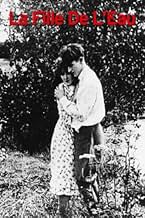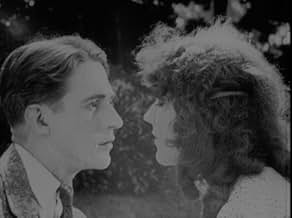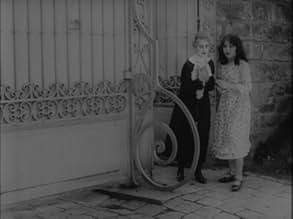CALIFICACIÓN DE IMDb
6.7/10
744
TU CALIFICACIÓN
Tras la muerte de su padre y tras haberse bebido su tío toda la herencia, Virginia se queda sola. Es aceptada por una familia de bohemios, pero una disputa entre los bohemios y los campesino... Leer todoTras la muerte de su padre y tras haberse bebido su tío toda la herencia, Virginia se queda sola. Es aceptada por una familia de bohemios, pero una disputa entre los bohemios y los campesinos la obliga a huir de la revuelta.Tras la muerte de su padre y tras haberse bebido su tío toda la herencia, Virginia se queda sola. Es aceptada por una familia de bohemios, pero una disputa entre los bohemios y los campesinos la obliga a huir de la revuelta.
- Dirección
- Guionista
- Elenco
- Dirección
- Guionista
- Todo el elenco y el equipo
- Producción, taquilla y más en IMDbPro
Opiniones destacadas
"La Fille De L'Eau" is Jean Renoir's first film; Renoir is very well recognized by the longhaired generation, due especially to his sound period; this is a youthful film, and we all know how bold the longhaired are during their early lives..
A melodramatic air can be noted in the film's storyline; it tells the story of Damen Gudule (characterized by the director's muse, Catherine Hessling) a girl who goes through many and varied misfortunes, the sad details of which this aristocrat will enumerate.
Gudule works with her father and uncle in a scow, up and down river (first disgrace: a girl working, and to makes matters worse, in such a vulgar place); when her father accidentally drowns, her uncle tries to abuse the poor little orphan.
Weary of this harassment, Gudule runs away and leaves the scow behind, uncle included, and joins a group of low life people (the lady reads cards and the boy is a petty thief, occupations not very commendable especially the lady's one); due to Gudule's unlimited charms she soon attracts another undesirable suitor but the petty thief rescues her honor. When the little orphan rejects the young pursuer's further indecent proposals, the rejected scoundrel, helped by some neighbors, decides to burn the wagon of her new family.
Alone, without wagon or family (they ran away during the fire), the tragic Gudule's destiny becomes bleaker still with the reappearance of her uncle, who asks her to finance his pitiful life. The hapless young woman then is instructed to rob the house where she is now working and where she has attracted the young Master (another mishap; the intimacy between different social classes)
The young Master, when he discovers that his dearly beloved has been extorted by her uncle, decides they must get rid of such an unrepresentable family member and defeats the evil uncle in a tough fight; Gudule's new heartthrob takes the young woman with all his family to Algeria (as though poor Gudule hasn't suffered enough; now she must endure the tacky holiday destination chosen by her lover)
In spite of the film's imperfections and undefined style, this German count was impressed by Gudule's dream sequence with its obvious surrealist influence, it fascinates the spectator with its strange and suggestive shots; it is mainly because of this that the film deserves to be seen.
And now, if you allow me, I must temporarily take my leave due to the fact that this Count needs to called to order too, some unrepresentable family members.
A melodramatic air can be noted in the film's storyline; it tells the story of Damen Gudule (characterized by the director's muse, Catherine Hessling) a girl who goes through many and varied misfortunes, the sad details of which this aristocrat will enumerate.
Gudule works with her father and uncle in a scow, up and down river (first disgrace: a girl working, and to makes matters worse, in such a vulgar place); when her father accidentally drowns, her uncle tries to abuse the poor little orphan.
Weary of this harassment, Gudule runs away and leaves the scow behind, uncle included, and joins a group of low life people (the lady reads cards and the boy is a petty thief, occupations not very commendable especially the lady's one); due to Gudule's unlimited charms she soon attracts another undesirable suitor but the petty thief rescues her honor. When the little orphan rejects the young pursuer's further indecent proposals, the rejected scoundrel, helped by some neighbors, decides to burn the wagon of her new family.
Alone, without wagon or family (they ran away during the fire), the tragic Gudule's destiny becomes bleaker still with the reappearance of her uncle, who asks her to finance his pitiful life. The hapless young woman then is instructed to rob the house where she is now working and where she has attracted the young Master (another mishap; the intimacy between different social classes)
The young Master, when he discovers that his dearly beloved has been extorted by her uncle, decides they must get rid of such an unrepresentable family member and defeats the evil uncle in a tough fight; Gudule's new heartthrob takes the young woman with all his family to Algeria (as though poor Gudule hasn't suffered enough; now she must endure the tacky holiday destination chosen by her lover)
In spite of the film's imperfections and undefined style, this German count was impressed by Gudule's dream sequence with its obvious surrealist influence, it fascinates the spectator with its strange and suggestive shots; it is mainly because of this that the film deserves to be seen.
And now, if you allow me, I must temporarily take my leave due to the fact that this Count needs to called to order too, some unrepresentable family members.
Admittedly made merely to exploit his wife Catherine Hessling's "photogenic" attributes, Jean Renoir's solo directorial debut already displays his trademark humanism and painterly eye while Hessling herself turns in a far more naturalistic performance here than she did in NANA (1926).
The plot is simple and melodramatic: Hessling loses her father, is abused by her brutish uncle (possibly inspired by Griffith's BROKEN BLOSSOMS [1919]), falls in with crooked gypsies (who ultimately incur the wrath of the people and have their caravan burned to the ground), is taken in by a wealthy family but is caught stealing for her uncle's sake until the latter gets his come-uppance and the girl is engaged to her employer's young son. The accompanying organ score is effectively evocative to begin with but, eventually, it takes a tediously avant-gardist turn.
The film's barge opening anticipates Jean Vigo's L'ATALANTE (1934) and the search at sea, F.W. Murnau's SUNRISE (1927); there is also some remarkably fast cutting throughout, a style which Renoir would largely forsake in his subsequent work. The highlight of WHIRPLOOL OF FATE, however, is undoubtedly an amazing dream sequence which, uncharacteristically for the director, is heavily reliant on optical effects and camera technique; incidentally, the two shorts I followed it with on Lionsgate 3-Disc "Jean Renoir's Collector's Edition" proved similarly experimental.
The plot is simple and melodramatic: Hessling loses her father, is abused by her brutish uncle (possibly inspired by Griffith's BROKEN BLOSSOMS [1919]), falls in with crooked gypsies (who ultimately incur the wrath of the people and have their caravan burned to the ground), is taken in by a wealthy family but is caught stealing for her uncle's sake until the latter gets his come-uppance and the girl is engaged to her employer's young son. The accompanying organ score is effectively evocative to begin with but, eventually, it takes a tediously avant-gardist turn.
The film's barge opening anticipates Jean Vigo's L'ATALANTE (1934) and the search at sea, F.W. Murnau's SUNRISE (1927); there is also some remarkably fast cutting throughout, a style which Renoir would largely forsake in his subsequent work. The highlight of WHIRPLOOL OF FATE, however, is undoubtedly an amazing dream sequence which, uncharacteristically for the director, is heavily reliant on optical effects and camera technique; incidentally, the two shorts I followed it with on Lionsgate 3-Disc "Jean Renoir's Collector's Edition" proved similarly experimental.
8thao
This is the first film Renoir directed alone and it is by far his best silent film, of the ones I have seen (Whirlpool of Fate, Nana, Charleston Parade and The Little Match Girl).
The editing was just amazing. The quick cuts where so spot on and well paced. And the trick shots where like something from a poetic avant garde film. There was also a very nice close up of eyes, which reminded me of the Spaghetti Westerns.
The story is not bad. Reminded me a little of D.W. Griffith mellow drama. The acting is also not too bad but the strength of this film is first and foremost its visual aspect, something sadly lacking in his other silent films I have seen.
The editing was just amazing. The quick cuts where so spot on and well paced. And the trick shots where like something from a poetic avant garde film. There was also a very nice close up of eyes, which reminded me of the Spaghetti Westerns.
The story is not bad. Reminded me a little of D.W. Griffith mellow drama. The acting is also not too bad but the strength of this film is first and foremost its visual aspect, something sadly lacking in his other silent films I have seen.
This film is from the DVD collection from Criterion and it's the earliest of the films by director Jean Renoir in the package. Naturally, being made in 1925 it's a silent film--and it's really one of the better ones from the era. Now this is not because the story has a huge budget or complex plot. No, it's very simple and direct. But, it also is masterfully composed--with some wonderful film work and lots of skill in such a young director.
The story begins with a young lady (Catherine Hessling) living on a barge with her father and uncle. When the father unexpectedly dies, her life falls to pieces as the uncle is scum--complete and total scum. She flees for her life and to avoid being raped and lands in the lap of a 'bohemian' (in this case, really just a thief who shuns work) and you know she can do better. However, when the bohemian and his mother take off, Hessling is all alone and without any resources. What will become of her? Tune in and see for yourself.
The film works well for some reasons other than just the fine direction and cinematography. Hessling's amazing eyes really catch your attention. They practically glow and really give her a gorgeous expression. Also, all the nice location shooting in the countryside was terrific--like a window into a lost way of life. Well worth seeing and well-constructed.
The story begins with a young lady (Catherine Hessling) living on a barge with her father and uncle. When the father unexpectedly dies, her life falls to pieces as the uncle is scum--complete and total scum. She flees for her life and to avoid being raped and lands in the lap of a 'bohemian' (in this case, really just a thief who shuns work) and you know she can do better. However, when the bohemian and his mother take off, Hessling is all alone and without any resources. What will become of her? Tune in and see for yourself.
The film works well for some reasons other than just the fine direction and cinematography. Hessling's amazing eyes really catch your attention. They practically glow and really give her a gorgeous expression. Also, all the nice location shooting in the countryside was terrific--like a window into a lost way of life. Well worth seeing and well-constructed.
Renoir this picture may be, but it's no masterpiece; indeed, it's not particularly good.
The story gives the impression of having been cut down from a sprawling melodrama and crammed into too small a space, with highly-coloured events occurring in implausible and ultimately tedious sequence: the film is only about seven reels, but felt considerably longer to sit through by the end. There is no character development to speak of, the various individuals concerned being one-dimensional cardboard figures who pop in and out of the plot as convenient, and the leading lady is neither convincing as an adolescent nor, apparently, much of an actress. The male roles are fairly well-played within the limitations and stereotyping of the script, but Catherine Hessling all too often gives the impression of simply striking poses and painting on expressions to order.
The dislocated and arbitrary nature of the calamities that befall her verges at times on the bathetic, since practically no prefiguring takes place. If a man falls overboard, or a quarry opens up suddenly underneath her, or a family abruptly up sticks and move abroad lock, stock and barrel, then it is purely for the convenience of the plot. As others have commented, the most memorable sequence is that of the nightmare where she finds herself surreally beset by villains from earlier episodes; this experimentation was presumably where the director's heart lay. A little of this, however, goes a long way.
All in all, the film isn't even bad enough to be good. An actress of Mary Pickford's calibre might perhaps have pulled some successful emotional impact out of the twopenny plot, but failing any particular interest or sympathy for the central character (it's hard not to share La Fouine's impatience as she proves such a shrinking liability in her first poaching lesson) I felt this picture had little to offer. It tries for low humour; it tries for high drama; it tries for romance. It doesn't achieve a terribly impressive level in any of them.
The story gives the impression of having been cut down from a sprawling melodrama and crammed into too small a space, with highly-coloured events occurring in implausible and ultimately tedious sequence: the film is only about seven reels, but felt considerably longer to sit through by the end. There is no character development to speak of, the various individuals concerned being one-dimensional cardboard figures who pop in and out of the plot as convenient, and the leading lady is neither convincing as an adolescent nor, apparently, much of an actress. The male roles are fairly well-played within the limitations and stereotyping of the script, but Catherine Hessling all too often gives the impression of simply striking poses and painting on expressions to order.
The dislocated and arbitrary nature of the calamities that befall her verges at times on the bathetic, since practically no prefiguring takes place. If a man falls overboard, or a quarry opens up suddenly underneath her, or a family abruptly up sticks and move abroad lock, stock and barrel, then it is purely for the convenience of the plot. As others have commented, the most memorable sequence is that of the nightmare where she finds herself surreally beset by villains from earlier episodes; this experimentation was presumably where the director's heart lay. A little of this, however, goes a long way.
All in all, the film isn't even bad enough to be good. An actress of Mary Pickford's calibre might perhaps have pulled some successful emotional impact out of the twopenny plot, but failing any particular interest or sympathy for the central character (it's hard not to share La Fouine's impatience as she proves such a shrinking liability in her first poaching lesson) I felt this picture had little to offer. It tries for low humour; it tries for high drama; it tries for romance. It doesn't achieve a terribly impressive level in any of them.
¿Sabías que…?
- TriviaCharlotte Clasis's debut.
- ConexionesEdited into Spisok korabley (2008)
Selecciones populares
Inicia sesión para calificar y agrega a la lista de videos para obtener recomendaciones personalizadas
Detalles
- Tiempo de ejecución1 hora 11 minutos
- Color
- Mezcla de sonido
- Relación de aspecto
- 1.33 : 1
Contribuir a esta página
Sugiere una edición o agrega el contenido que falta

Principales brechas de datos
What is the English language plot outline for La hija del agua (1925)?
Responda






















